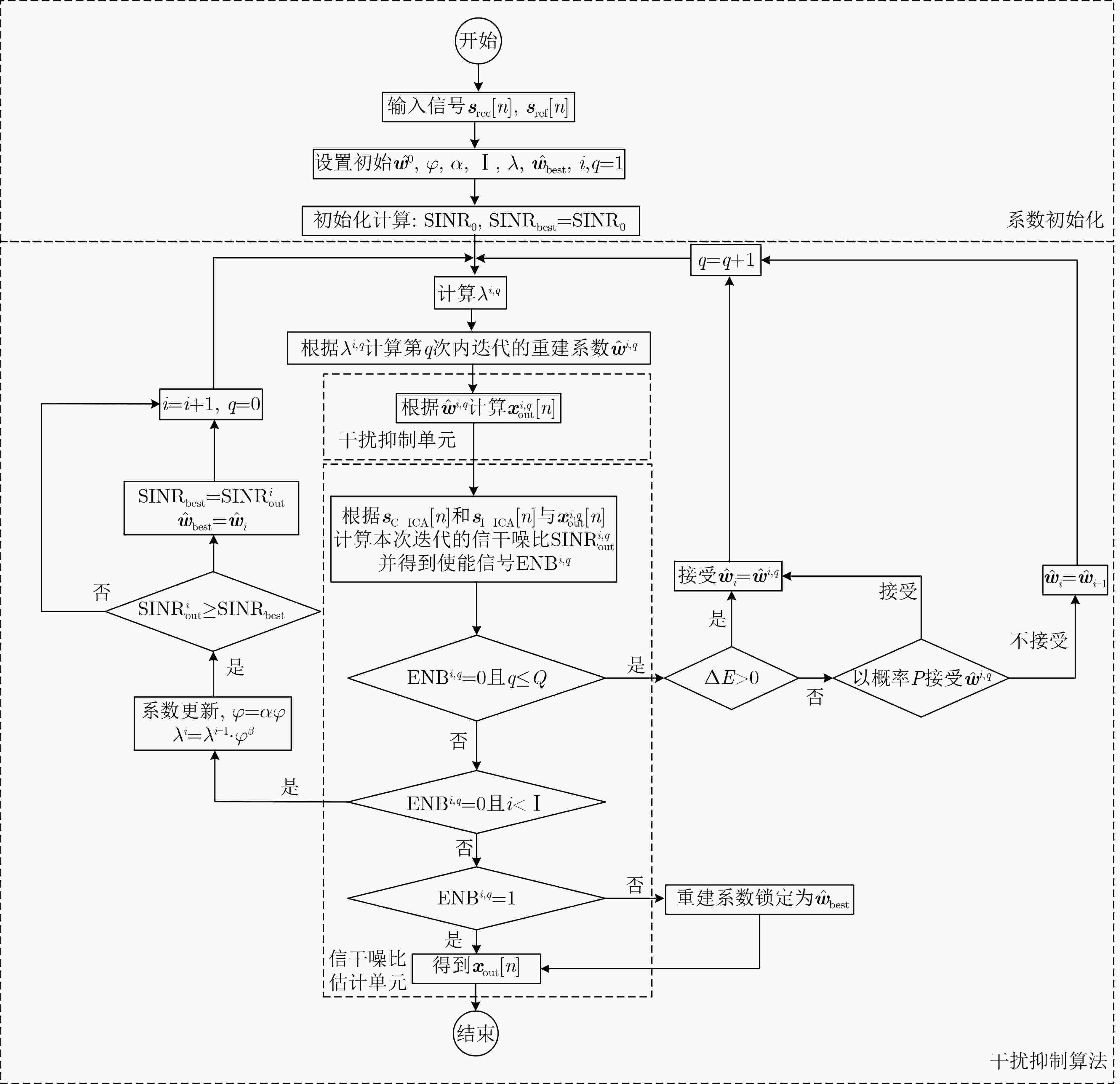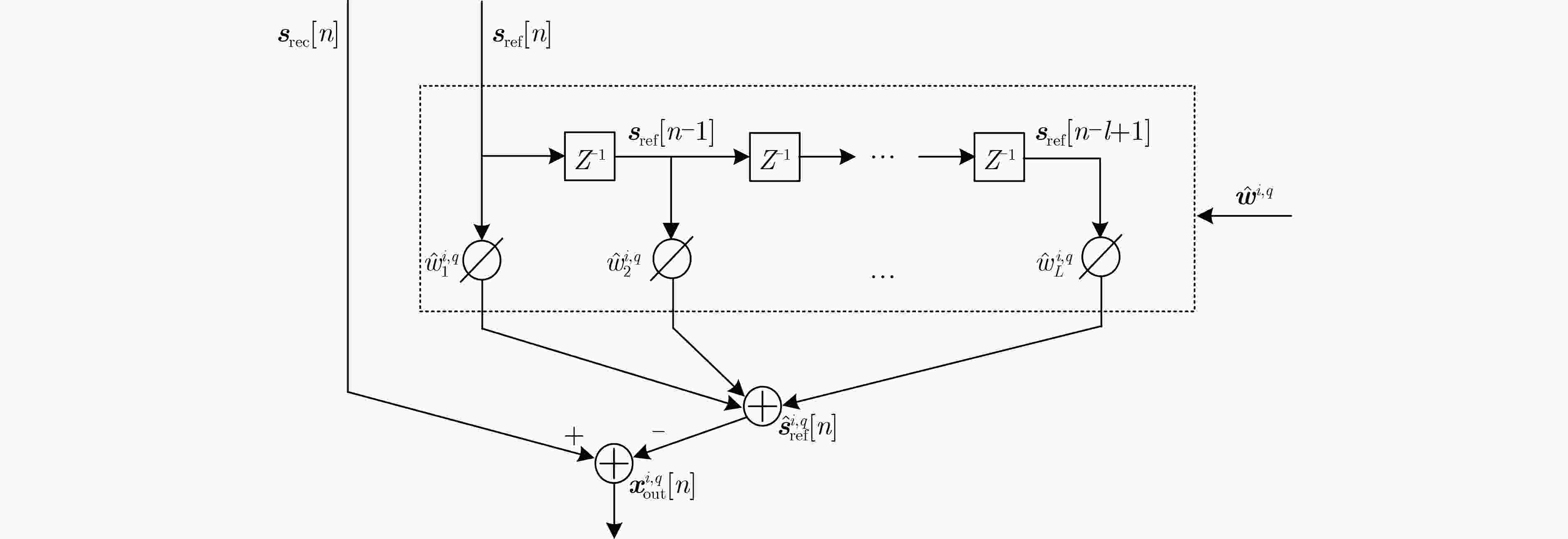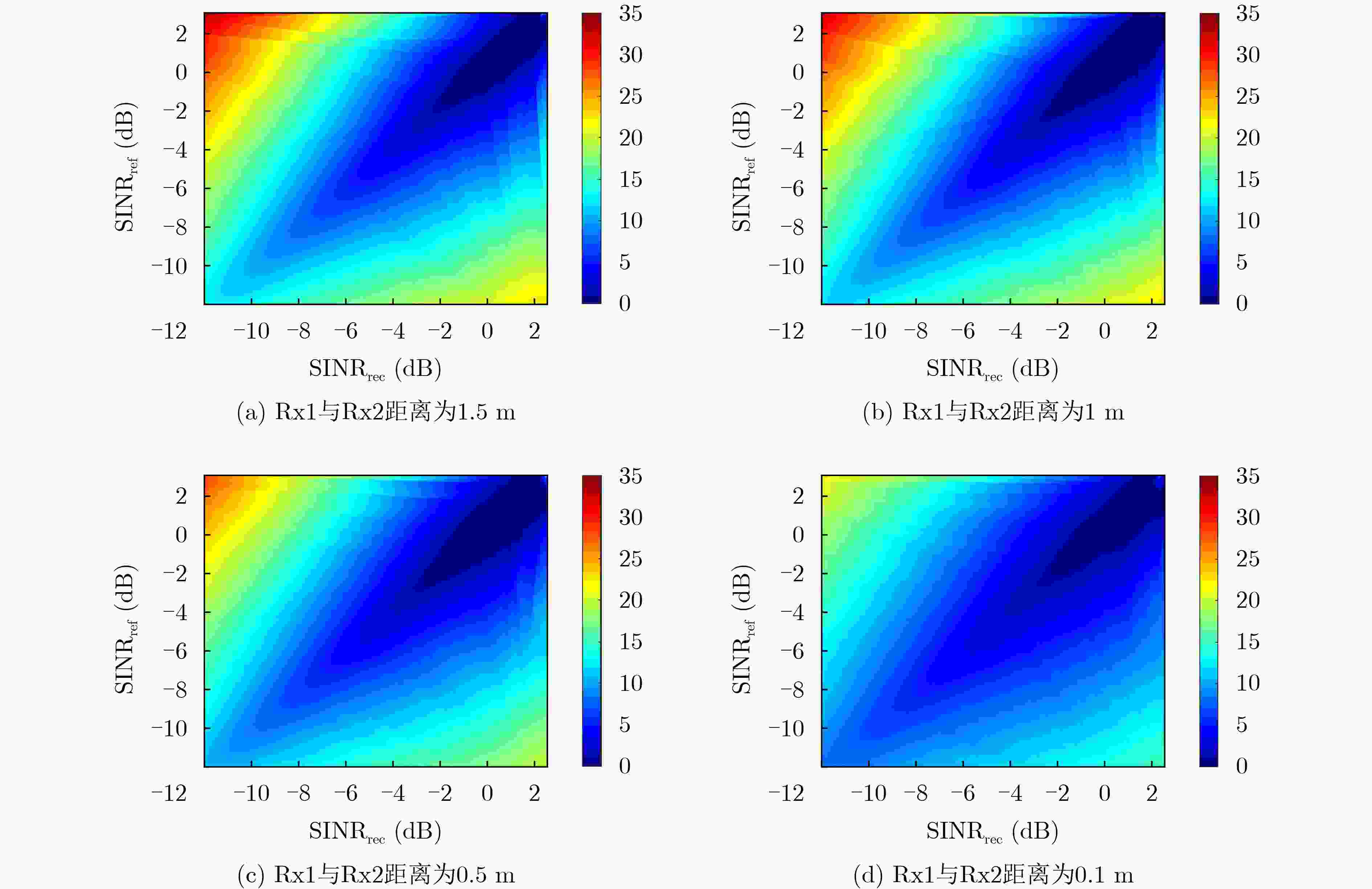Research on Non-cooperative Interference Suppression Technology for Dual Antennas without Channel Prior Information
-
摘要: 在电子对抗中,己方通信信号极易受到敌方干扰。针对非合作干扰信号抑制,通常选择辅助天线来提取干扰信号样本,对受扰的通信信号进行干扰抑制,进而保证通信质量。但辅助天线可能同时收到干扰信号和通信信号,影响干扰信号样本的获取,降低干扰抑制能力。该文在非合作干扰场景下,提出了一种快速独立成分分析联合模拟退火最大化输出信干噪比的干扰抑制方法,该方法通过快速独立成分分析方法来估计信干噪比、模拟退火算法搜索重建系数、重建滤波器结合重建系数得到干扰抑制后信号。仿真和实验证明:当双天线的信干噪比差异较大,或通信信号和辅助信号各自到达双天线的信道相关性较弱时,所提方法具备更优异的干扰抑制性能。在双天线具有14.8 dB的信干噪比差时,该方法可实现34.4 dB的干扰抑制比。Abstract:
Objective In electronic countermeasures, friendly communication links are vulnerable to interference from adversaries. The auxiliary antenna scheme is employed to extract reference signals for interference cancellation, which improves communication quality. Although the auxiliary antenna is designed to capture interference signals, it often receives communication signals at the same time, and this reduces the suppression capability. Typical approaches for non-cooperative interference suppression include interference rejection combining and spatial domain adaptive filtering. These approaches rely on the uncorrelated nature of the interference and desired signals to achieve suppression. They also require channel information and interference noise information, which restricts their applicability in some scenarios. Methods This paper proposes the Fast ICA-based Simulated Annealing Algorithm for SINR Maximization (FSA) to address non-cooperative interference suppression in communication systems. Designed for scenarios without prior channel information, FSA applies a weighted reconstruction cancellation method implemented through a Finite Impulse Response (FIR) filter. The method operates in a dual-antenna system in which one antenna supports communication and the other provides an auxiliary reference for interference. Its central innovation is the optimization of weighted reconstruction coefficients using the Simulated Annealing algorithm, together with Fast Independent Component Analysis (Fast ICA) for SINR estimation. The FIR filter reconstructs interference from the auxiliary antenna signal using optimized coefficients and then subtracts this reconstructed interference from the main received signal to improve communication quality. Accurate SINR estimation in non-cooperative settings is difficult because the received signals contain mixed components. FSA addresses this through blind source separation based on Fast ICA, which extracts sample signals of both communication and interference components. SINR is then calculated from cross-correlation results between these separated signals and the signals after interference suppression. The Simulated Annealing algorithm functions as a probabilistic optimization process that adjusts reconstruction coefficients to maximize the output SINR. Starting from initial coefficients, the algorithm perturbs them and evaluates the resulting SINR. Using the Monte Carlo acceptance rule, it allows occasional acceptance of perturbations that do not yield immediate improvement, which supports escape from local optima and promotes convergence toward global solutions. This iterative process identifies optimal filter coefficients within the search range. The combined use of Fast ICA and Simulated Annealing enables interference suppression without prior channel information. By pairing blind estimation with robust optimization, the method provides reliable performance in dynamic interference environments. The FIR-based structure offers a practical basis for real-time interference cancellation. FSA is therefore suitable for electronic countermeasure applications where channel conditions are unknown and change rapidly. This approach advances beyond conventional techniques that require channel state information and offers improved adaptability in non-cooperative scenarios while maintaining computational efficiency through the combined use of blind source separation and intelligent optimization. Results and Discussions The performance of the proposed FSA is assessed through simulations and experiments. The output SINR is improved under varied conditions. In simulations, a maximum SINR improvement of 27.2 dB is achieved when the communication and auxiliary antennas have a large SINR difference and are placed farther apart (Fig. 5). The performance is reduced when the channel correlation between the antennas increases. Experimental results confirm these observations, and an SINR improvement of 19.6 dB is measured at a 2 m antenna separation (Fig. 7). The method is shown to be effective for non-cooperative interference suppression without prior channel information, although its performance is affected by antenna configuration and channel correlation. Conclusions The proposed FSA method provides an effective solution for non-cooperative interference suppression in communication systems. The method applies weighted reconstruction cancellation optimized by the Simulated Annealing algorithm and uses Fast ICA-based SINR estimation to improve communication quality without prior channel information. The results from simulations and experiments show that the method performs well across varied conditions and has potential for practical electronic warfare applications. The study finds that the performance of the FSA method depends on the SINR difference and the channel correlation between the communication and auxiliary antennas. Future research focuses on refining the algorithm for more complex scenarios and examining the effect of system parameters on its performance. These findings support the development of communication systems that operate reliably in challenging interference environments. -
-
[1] WINTERS J H. Optimum combining in digital mobile radio with cochannel interference[J]. IEEE Transactions on Vehicular Technology, 1984, 33(3): 144–155. doi: 10.1109/T-VT.1984.24001. [2] LIU Fengwei, ZHAO Hongzhi, and TANG Youxi. An Eigen domain interference rejection combining algorithm for narrowband interference suppression[J]. IEEE Communications Letters, 2014, 18(5): 813–816. doi: 10.1109/LCOMM.2014.033014.140198. [3] LIU Fengwei, ZHAO Hongzhi, QUAN Xin, et al. Eigen domain interference rejection combining algorithm for MIMO systems[J]. IEEE Communications Letters, 2016, 20(5): 850–853. doi: 10.1109/LCOMM.2016.2538258. [4] YAN Zhiting, HE Guanghui, and MA Jun. An enhanced IRC algorithm for LTE downlink receiver in multi-cell environment[J]. Chinese Journal of Electronics, 2014, 23(2): 377–381. doi: 10.23919/CJE.2014.10851900. [5] 马万治, 赵宏志, 于辉越, 等. LTE上行通信链路中Wi-Fi同频干扰的一种抑制方法[J]. 通信学报, 2012, 33(8): 106–112. doi: 1000-436X(2012)08-0106-07.MA Wanzhi, ZHAO Hongzhi, YU Huiyue, et al. Wi-Fi co-channel interference suppression approach in LTE uplink[J]. Journal on Communications, 2012, 33(8): 106–112. doi: 1000-436X(2012)08-0106-07. [6] KUMAR K, BODDAPATI H K, and REDDY CHAVVA A K. Low complexity interference rejection combining equalizer for extreme massive MIMO[C]. Proceedings of 2024 IEEE Wireless Communications and Networking Conference (WCNC), Dubai, United Arab Emirates, 2024: 1–6. doi: 10.1109/WCNC57260.2024.10570661. [7] ZHU Yubin, YANG Ruobing, GAO Ya, et al. Stochastic gradient descent based MIMO detection with interference rejection combining[C]. Proceedings of 2024 IEEE 24th International Conference on Communication Technology (ICCT), Chengdu, China, 2024: 538–543. doi: 10.1109/ICCT62411.2024.10946447. [8] CHEN Jue, LU Siyao, WANG T Y, et al. A three-stage-concatenated non-linear MMSE interference rejection combining aided MIMO-OFDM receiver and its EXIT-chart analysis[J]. IEEE Open Journal of Vehicular Technology, 2024, 5: 507–522. doi: 10.1109/OJVT.2024.3375217. [9] XU Jingwei, LIAO Guisheng, ZHU Shengqi, et al. Response vector constrained robust LCMV beamforming based on semidefinite programming[J]. IEEE Transactions on Signal Processing, 2015, 63(21): 5720–5732. doi: 10.1109/TSP.2015.2460221. [10] FROST O L. An algorithm for linearly constrained adaptive array processing[J]. Proceedings of the IEEE, 1972, 60(8): 926–935. doi: 10.1109/PROC.1972.8817. [11] WANG Qing, HE Fangmin, MENG Jin, et al. Auxiliary array optimization for suppressing co-site spurious interference with a sidelobe canceller[C]. Proceedings of 2019 Joint International Symposium on Electromagnetic Compatibility, Sapporo and Asia-Pacific International Symposium on Electromagnetic Compatibility (EMC Sapporo/APEMC), Sapporo, Japan, 2019: 495–498. doi: 10.23919/EMCTokyo.2019.8893671. [12] YANG Xiaopeng, YIN Pilei, and ZENG Tao. Mainlobe interference suppression based on large aperture auxiliary array[C]. Proceedings of 2012 IEEE Asia-Pacific Conference on Antennas and Propagation, Singapore, Singapore, 2012: 317–318. doi: 10.1109/APCAP.2012.6333273. [13] ZHANG Jiahao and MENG Jin. Auxiliary antenna array optimization for mainlobe interference suppression systems[C]. Proceedings of 2022 International Conference on Microwave and Millimeter Wave Technology (ICMMT), Harbin, China, 2022: 1–3. doi: 10.1109/ICMMT55580.2022.10023403. [14] GUO Yu, WANG Hengfeng, WU Hao, et al. Analysis and design of auxiliary array with intelligent optimization for interference suppression of vehicular communication[J]. IEEE Transactions on Vehicular Technology, 2024, 73(6): 8295–8305. doi: 10.1109/TVT.2024.3354770. [15] 李哲宇, 李亚星, 张嘉毫, 等. 非合作干扰对消技术中空间分辨率建模与分析[J]. 国防科技大学学报, 2024, 46(5): 45–53. doi: 10.11887/j.cn.202405006.LI Zheyu, LI Yaxing, ZHANG Jiahao, et al. Modeling and analysis of spatial resolution in noncooperative interference cancellation technique[J]. Journal of National University of Defense Technology, 2024, 46(5): 45–53. doi: 10.11887/j.cn.202405006. [16] HYVÄRINEN A and OJA E. Independent component analysis: Algorithms and applications[J]. Neural Networks, 2000, 13(4-5): 411–430. doi: 10.1016/S0893-6080(00)00026-5. -






 下载:
下载:








 下载:
下载:
